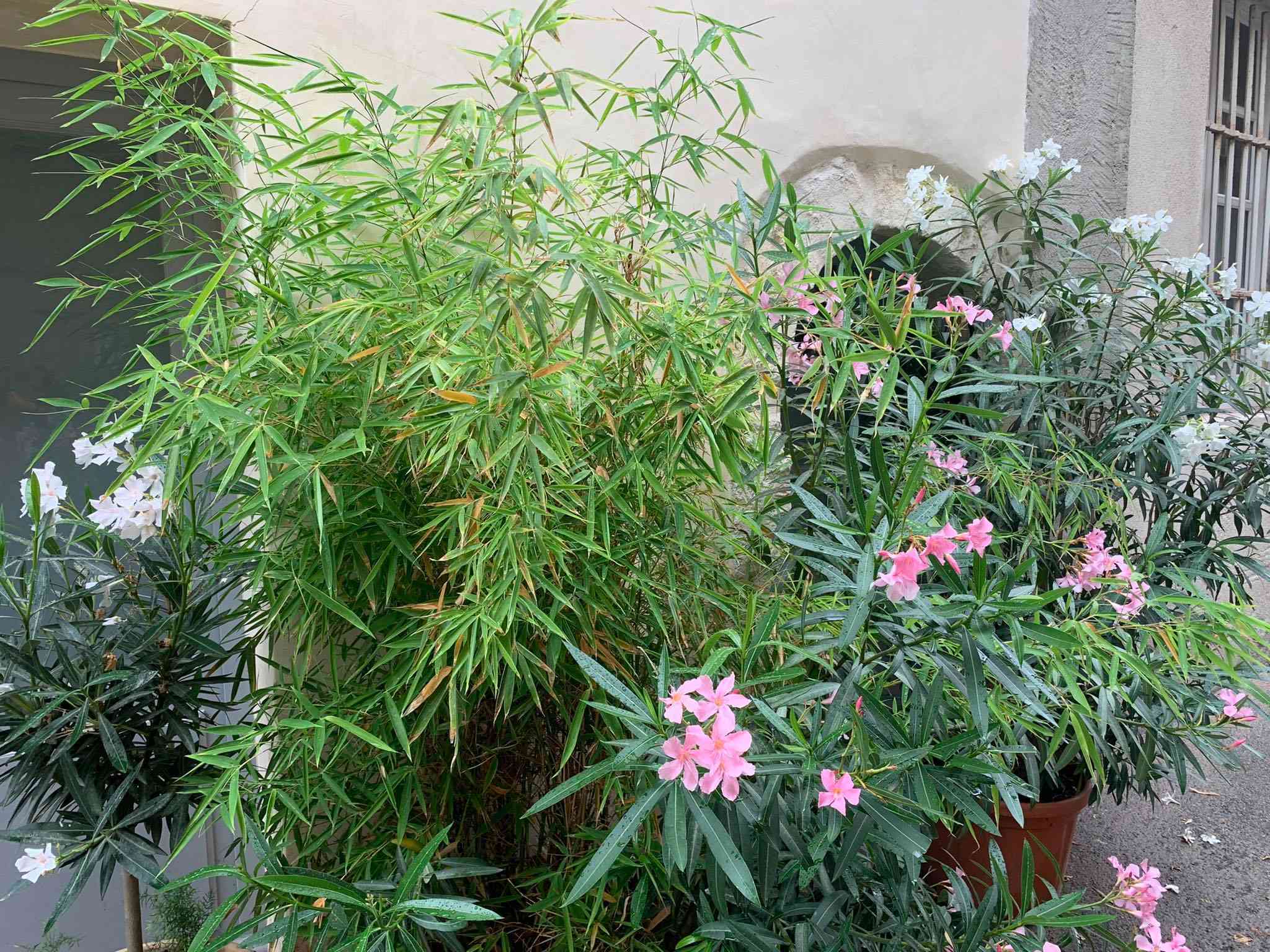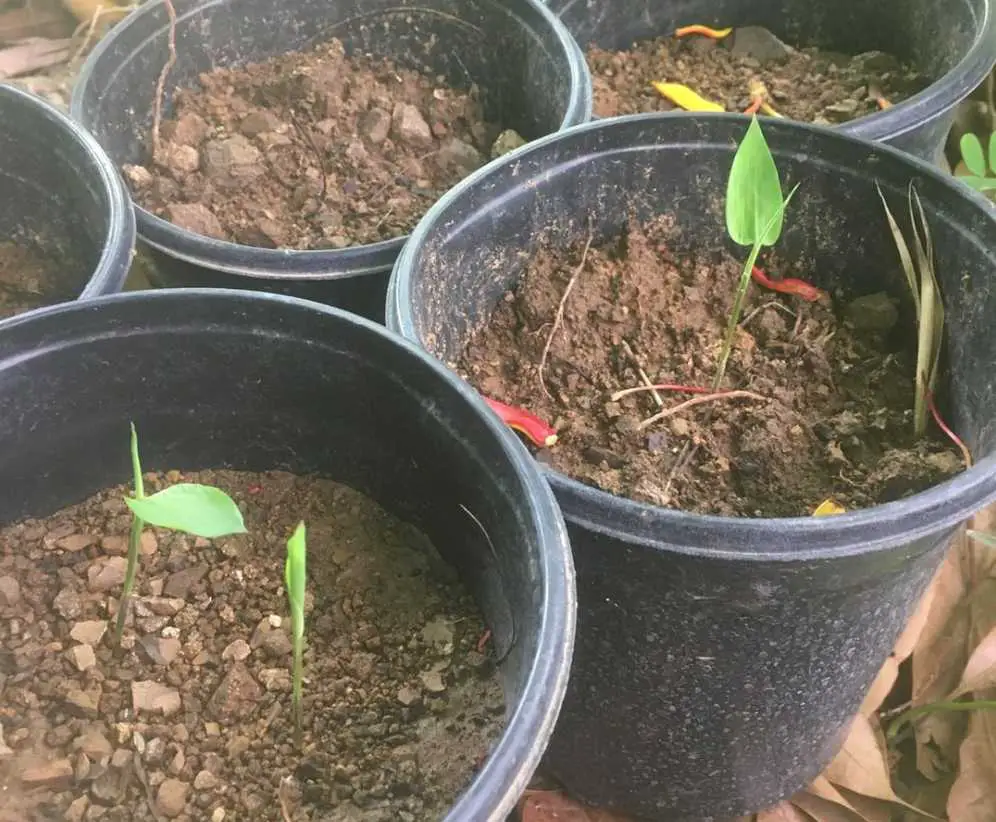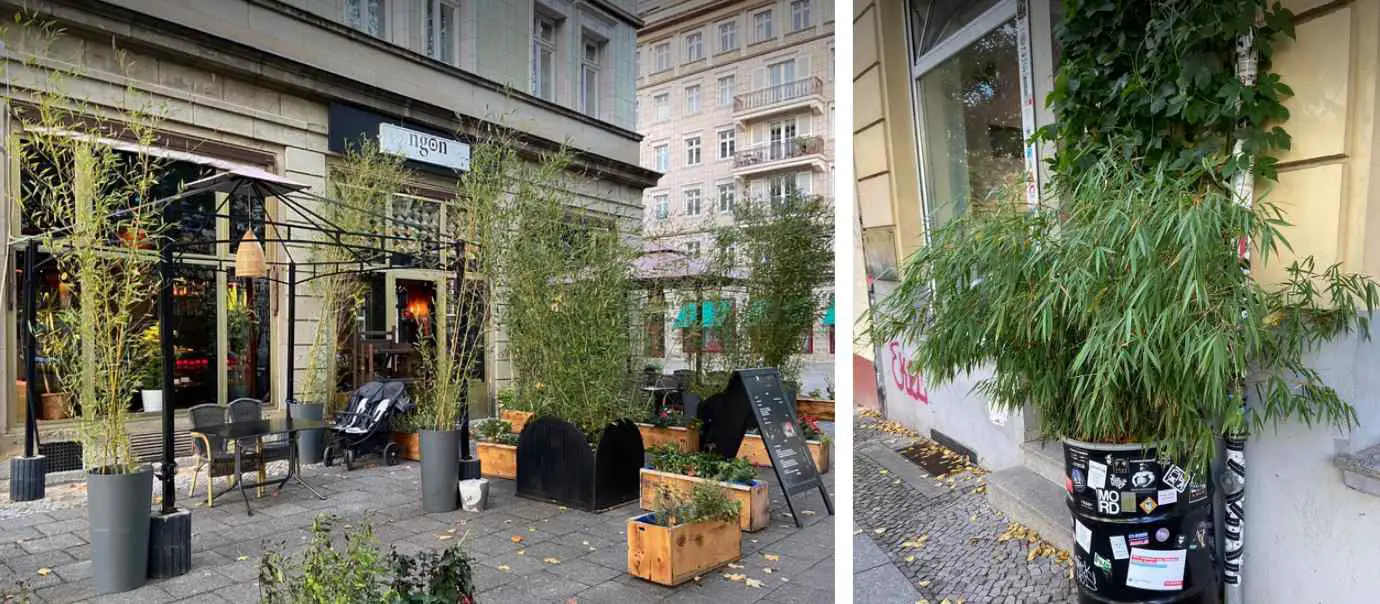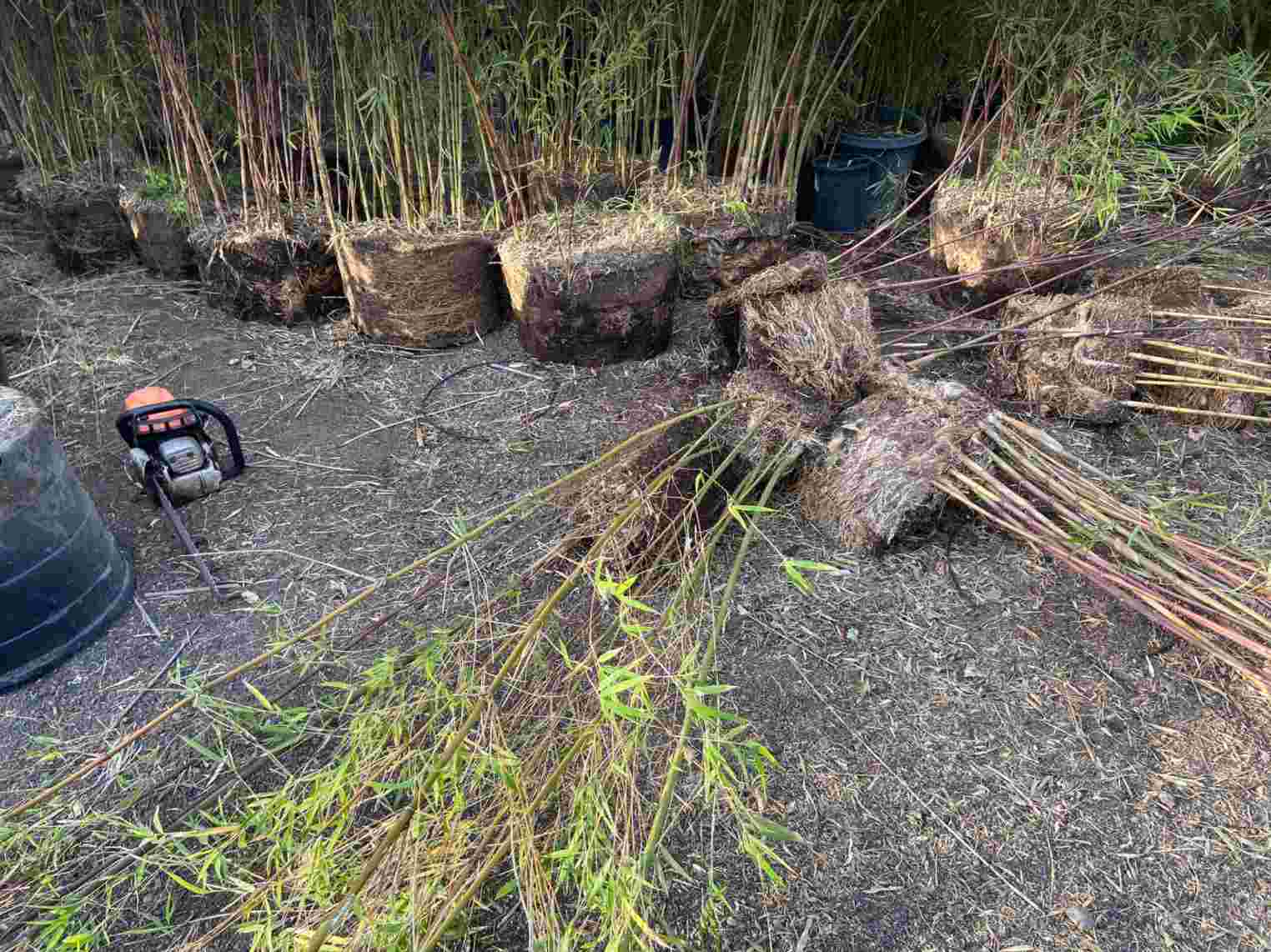A lot of gardeners are reluctant to plant bamboo for fear that its aggressive rhizomes will wreak havoc on their otherwise immaculate garden. This fear is not entirely unfounded. It’s true that many varieties of running bamboo, with their monopodial rhizomes, can spread everywhere and become almost impossible to remove. But with a little caution and forethought, you can pretty easily avoid this predicament.
One of the most popular and straightforward methods of taming your bamboo and protecting your garden is to keep it in a pot or planter box. There are many advantages to growing bamboo this way. It’s an effective way to keep a vigorous bamboo plant from overrunning your backyard. But there are also some drawbacks that every gardener should be aware of, as bamboo roots do prefer having a little room to spread out. So here we are going to take a closer look at the pros and cons.
NOTE: This article first appeared in July 2019, last updated in February 2024.
We’ve written about different ways to keep the grass from growing out of control in our article about bamboo containment and removal. We’ve also suggested an excellent selection of clumping bamboo species.

Bamboo in pots and planters
Like many topics in the natural world, there’s no simple, black-and-white answer to whether or not you should keep your bamboo in a pot or a box. Ultimately, the decision will depend on a variety of individual circumstances as well as your unique goals and personal preferences.
PROS of Potted Bamboo
- Bamboo in a pot will generally stay very well contained, without the rhizome roots getting into your vegetable patch or wrapping around underground things like irrigation pipes and utility lines. I say generally, because if you’re not careful, the bamboo can get from the pot into the earth. (See below.)
- If you want to create a privacy screen along a specific area of your garden, a row of pots or containers can make for a very well-defined hedge space.
- Should you decide to relocate your bamboo plant to a different place in your garden, or remove it altogether, this will be immensely easier when the bamboo is in a pot rather than rooted in the ground.
- Being able to move your bamboo with the seasons can also be useful. In the summer, for example, it might be happier in a shady corner of the garden. In a freak storm or blizzard, on the other hand, it might be best to bring it inside for a day or two.
- Bamboo is already a very attractive plant, and using pots allows you to introduce another decorative element to your garden scene. Rustic wood barrels look interesting, or perhaps you can find some elegant Asian pottery to compliment your zen aesthetics. Just be careful not to use pots that get narrow at the top; that will make transplanting very difficult.
- Watering and fertilizing might be easier when the plant has a very clearly defined place.
- When sprouting seeds, it’s definitely easier to keep your baby bamboo in a pot, when you can protect it from pests and the elements. (But beware, growing bamboo from seeds is a tricky business!)

CONS of Potted Bamboo and general precautions
- Keeping your bamboo in a pot might help you sleep easier at night. But it could also give you a false sense of security. It’s especially important to place something solid under your pot, otherwise the roots will eventually crawl through the drain hole and get into the soil. It could be months or years before your realize this. Best to set your bamboo pots on a solid deck, a concrete driveway, or some sort of stepping stone.
- Any plant that remains in a pot year after year is liable to get root bound. This is especially true for bamboo, with its vigorous rhizome root system. It will be essential to pull the bamboo out of its container at least once a year and trim the roots. Better still, you can split the root ball into two or three sections. (Yes, that means you’ll need to get more pots. But a potted bamboo plant can also make a great housewarming gift and a friendly gesture for a neighbor.)
- If you don’t trim the roots on a regular basis, two things are likely to happen. The root-bound plant will feel restricted, grow uncomfortable, and languish like a prisoner in a tight cell. But over time, the robust bamboo roots will probably burst through the container. Whether the pot is plastic, wood or ceramic, it will eventually give way to the effects of time and pressure.
- Even if you do prune your roots on a regular basis, most bamboos will never achieve their maximum size in a pot. If you want to grow timber bamboo, don’t expect to see 5-inch thick culms and 80-foot poles from a potted bamboo. Better to stick with more compact species or dwarf varieties.
- In most cases, watering bamboo in a container will require more care and attention. The soil in a pot will generally dry out more quickly than the soil in the open ground. Also, as the roots get crowded inside the pot, the water sometimes goes straight through without getting absorbed. In other cases, there could be insufficient drainage, and you could run into issues like root rot.

What are the best varieties of bamboo to plant in pots?
You can really put any bamboo into a pot if you want to. It’s just a matter of tending to the plant and making sure it doesn’t get root bound. But some species of bamboo are going to be more comfortable in a pot than others.
One of the most popular varieties of potted bamboo is Pseudosasa japonica, also known as Arrow Bamboo. It’s a runner, but with a fairly compact growth habit. It generally grows about 15 feet tall with 1 inch canes.
Otatea acuminata (Mexican Weeping Bamboo) is another popular option. This clumping bamboo grows bushy, with delicate, graceful leaves that rustle in the breeze. The dwarf variety of this species will do especially well in a container.
Chimonobambusa quadrangularis, also known as a Square Bamboo, is an exquisite species and an excellent candidate for potting. Easily recognized by its squarish rather than round culms, which are easy to show off because the branching doesn’t usually start until 2 or 3 feet above ground. This running variety grows about 10-15 feet tall and is cold hardy down to around 10º F.

You can also look for various types of dwarf bamboo. Dwarf white stripe (Pleioblastus variegatus) is a variety that I like to grow. Hiroshima Bamboo is another exotic and attractive species that’s very adaptable. And all the cultivars of Buddha Belly (including the dwarf, which does particularly wells in pots) are strikingly attractive, with their unusually shaped culms. Take a look at this article on Buddha Belly Bamboo.
Runners or clumpers?
You might assume that clumping bamboo is more suitable for a container, while runners want to spread out too much. But in fact, the enclosed pot does a good job of keeping the running roots contained. Just remember to check up on the roots regularly, as they will need to be divided and transplanted periodically. Clumping bamboo expands differently, and as for the larger tropical bamboo, they aren’t very happy in containers.

Choosing the best pot for your bamboo
Finally, after you’ve taken all these factors into consideration, you need to select an appropriate pot. Bamboo roots are not usually very deep, but they do like to spread. Therefore, the most suitable container will be something low and wide. Wider pots will give the roots a little room to stretch. Equally important, they will make it easier to remove the plant and repot it, or at least take it out and prune back those sprawling rhizomes.
Time to repot your bamboo
When you put a fast-growing plant like bamboo into a container, it will inevitably fill the pot and need transplanting. If you leave it in the same pot for too long, you will eventually see it in the health of the plant. The leaves may curl, or turn yellow, or simply look less vibrant. But ideally, you want to repot the plant before this happens.
Typically what you will see is that the roots get so bunched up in the container that the water cannot penetrate the soil and get down to the roots. So what really happens is that the bamboo is not getting enough water. But don’t worry if this happens, it’s not too late.

If you can pull the plant out of the pot and trim the rhizomes back before it gets root bound you’ll have a much easier time, and the bamboo will stay much happier. Otherwise, you’ll probably need to cut through the root ball with a saw.
When you pull a root-bound bamboo out of its container, the roots will basically retain the shape of the pot. Begin by sawing off the bottom inch or so of the root ball, where the roots are turning back on themselves. You may need to do the same around the sides, or you can simply cut through the ball and break it into 3 or 4 chunks.
It’s a messy process, but the ends will justify the means. When you’re finished you’ll have more bamboo plants than when you started, and they’ll be happier. They might take a couple of months to bounce back, but then you’ll have a flourishing garden, maybe even a few extra bamboo plants for your friends.
Remember to follow a few rules of thumb when repotting.
- Repot in early spring or fall, if you have a healthy root ball
- Repot in the winter, dormant season, if you need to divide the root mass of a root-bound bamboo
- Keep the roots and the soil moist as you go
- Be sure to have some extra pots and potting soil on hand
- Don’t fret if you lose a few culms in the process, especially the older, smaller ones
- Allow a few months for the plants to revitalize
Also, check out our in-depth article on When and how to repot your bamboo.
Conclusions
As you can see, there are a host of advantages to keeping your bamboo in a pot or container. And there are a few disadvantages, but most of them can be easily overcome. The bottom line is that you will have more flexibility when your bamboo is in a pot, and you won’t have the problem of bamboo rhizomes running amok in your garden.
The main thing is that you’ll have to repot and/or inspect the roots of your bamboo on a regular basis. But even with bamboo growing directly in the earth, it’s always a good idea to poke around the roots every few months.
Further reading
To learn more about gardening with bamboo, check out some of our other in-depth articles.
- A complete guide to growing bamboo
- How to choose the best bamboo for your garden
- Bonsai with bamboo
- Growing bamboo indoors
- How fast does bamboo grow?
- 10 Best bamboo varieties for your garden
FEATURED IMAGE: Bambusa multiplex growing in pots in Portugal. (Photo by Fred Hornaday)





















Is there a groundcover bamboo? Maybe like 6″-18″ in height, evergreen. I remember seeing a groundcover that had bamboo like leaves but I don’t think it was a bamboo….This was maybe 30 years ago, it was in a sunset western garden book.
Thank you in advance,
Yes, great question. Take a look at this article about Dwarf Bamboo and Groundcover Bamboo